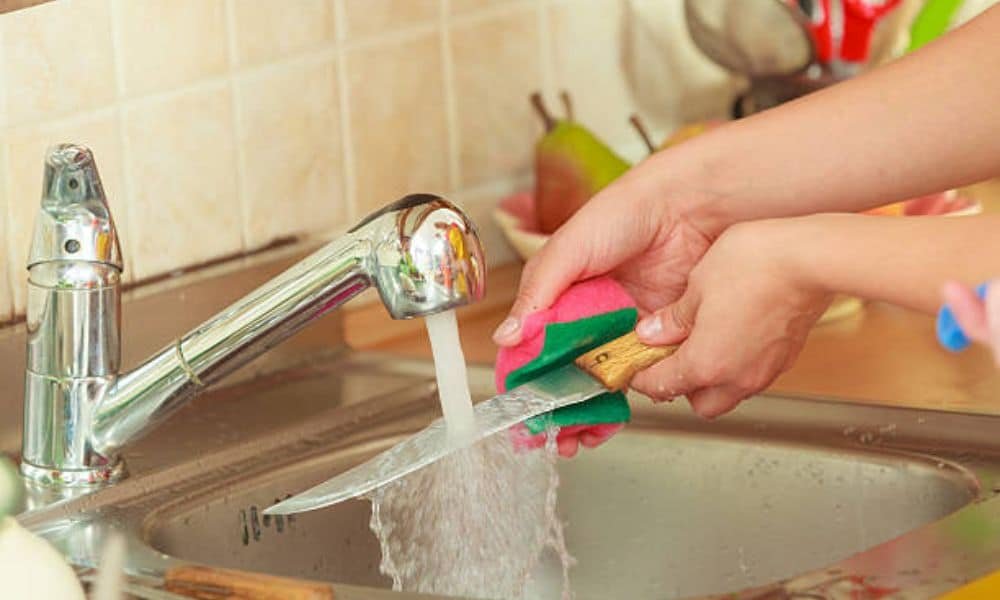Last week, I almost nicked my finger slicing onions—not because I was careless, But because my knife was dull and greasy. That’s when it hit me: knowing how to clean kitchen knives isn’t just about tidiness—it’s about safety, flavour, and keeping your tools in top shape. Over the years, I’ve learned A few tricks (and made a few mistakes). Let’s walk through them together—simple steps, Honest tips, And real kitchen wisdom you can trust.
The Basics: What You’ll Need to Clean Kitchen Knives
To clean your knives right, start simple. Use a soft sponge, a drop of dish soap, and a clean towel. These three tools protect your blade and help it last longer.
Avoid anything rough. Scrub pads and steel wool can scratch your blade. Even worse, they dull the edge. Keep it gentle.
Never toss knives in the dishwasher. The heat and water break down the handle. The blade also gets banged around and chipped. I made that mistake once—never again.
No need to spend big. I use soft cloths from the dollar bin. They work just fine and last For months. You don’t need a pro kit—just smart choices. Even the best kitchen knife set under 100 needs care. Clean them right, And they’ll cut like new every time. Think of It like brushing your teeth—small steps make A big difference.
Step-by-Step: How to Clean Kitchen Knives Safely
Cleaning your knives doesn’t take much time. A few quick steps can keep them sharp, safe, and ready for anything.
01. Rinse Right After Use
Hold your knife under warm water. This helps remove food before it sticks. It also makes washing easier And keeps your blade clean longer. Rinse knives with warm water As soon as you’re done using them.
02. Wash Gently With Soap and Sponge
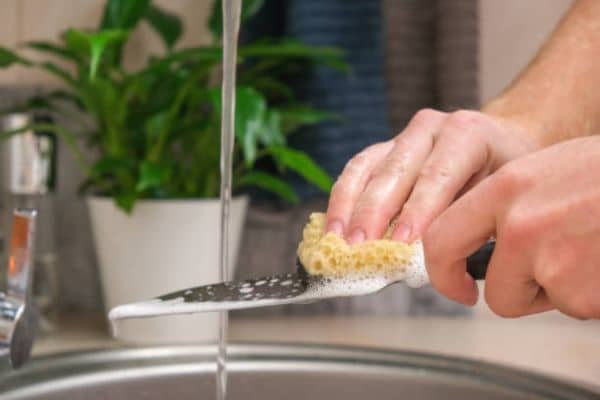
Add a drop of mild dish soap to a soft sponge. Gently scrub the blade from spine to edge. Keep your fingers away from the sharp side. Use mild soap and a soft sponge to clean kitchen knives safely.
03. Dry Immediately
Use a clean towel. Pat the blade dry from handle to tip. Letting water sit can cause rust, even on stainless steel. Dry knives right after washing to prevent rust or water spots.
04. (Optional) Oil Carbon Steel Blades
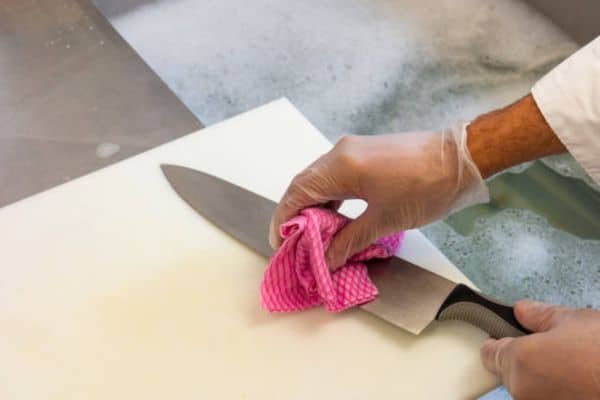
Rub a drop of food-safe mineral oil on the blade. This helps stop rust and keeps the steel smooth. It’s a quick job that makes a big impact. Use light oil on carbon steel blades to keep them from rusting.
Common Mistakes That Ruin Kitchen Knives
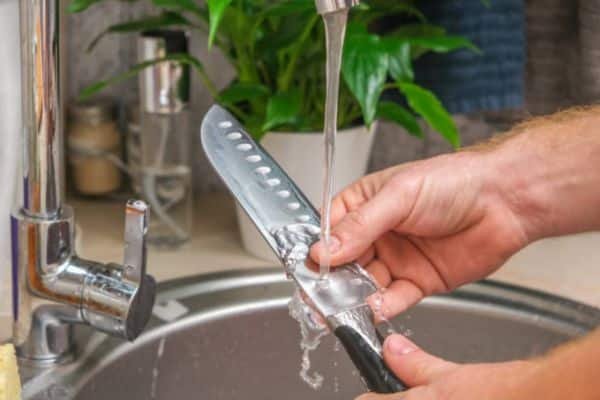
Most knife damage doesn’t happen while cutting. It happens right after.
Mistake #1: Leaving Knives Wet or Soaking
Water is a blade’s worst enemy. Leaving knives wet leads to rust, stains, and loose handles. Even stainless steel can suffer. Always dry your knife right after washing. Never leave it in the sink.
Mistake #2: Washing in the Dishwasher
Dishwashers may be quick, but they’re rough. Heat warps handles. High pressure dulls the edge. The blade also knocks into other tools.
Mistake #3: Storing Them Loosely in a Drawer
Loose storage chips the edge and dulls the point. You might also cut yourself reaching in. It’s unsafe and shortens the knife’s life.
Knife Care Tips on a Budget
Great knife care doesn’t need fancy tools or pricey gadgets. A soft sponge, mild soap, and dry towel go a long way—even for knives that cost less.
Cleaning helps your blades last longer. Even low-cost knives can perform well with the right care. Wipe them clean, dry them fast, and avoid harsh tools.
I’ve tested a few affordable sets in my kitchen. One of my favourites? The best kitchen knife set under 100 I grabbed during a holiday sale. With regular hand-washing and smart storage, those knives still slice like champs.
You don’t need to spend much to protect your investment. Try blade guards, wall strips, or drawer trays—many cost less than a coffee. Keep your tools clean, and they’ll serve you well every meal.
How to Store Knives After Cleaning
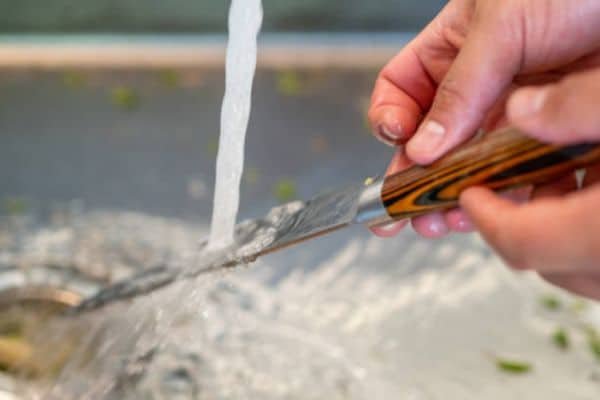
Cleaning your knives is only half the job. Storing them right keeps them sharp, safe, and easy to reach.
Use of Magnetic Strips, Knife Blocks, and Blade Guards
A magnetic strip on the wall saves space and shows off your tools. A wooden block keeps blades safe and upright. Blade guards are great for drawers or travel.
Simple Storage for Small Kitchens
No room on the counter? Try slim in-drawer knife trays or compact strips inside a cabinet door. I live in a small space, and this switch changed my whole setup.
Safety and Longevity Tips
Never toss knives in a drawer loose. Blades get dull fast and can nick your fingers. Give each knife its own spot, and make sure it’s clean and dry before storing.
Final Thoughts
Knife care doesn’t have to feel like a chore. Once it becomes part of your kitchen rhythm, it’s second nature—like wiping down the counter or boiling water for tea.
A clean knife works better, feels safer, and helps your food taste the way it should. There’s real peace in knowing your tools are ready and reliable.
Even the best kitchen knife set under 100 can last for years. It just needs a little love. Wash it by hand, dry it fast, and give it a safe place to rest. That’s all it takes.
FAQs
Can I use vinegar or baking soda?
Yes—but with care. Vinegar can remove stains, and baking soda works for stuck-on grime. Use them gently and rinse right away. Don’t scrub hard or leave them sitting too long.
What if I already put my knife in the dishwasher?
Don’t worry—it happens! Just check the handle and edge. If nothing looks warped or chipped, start hand-washing from now on. A little oil can help recover a dry blade.
How often should I clean knives I don’t use often?
Wipe them every few weeks. Even unused knives can gather dust or moisture. A quick clean and dry helps keep them ready for action.

